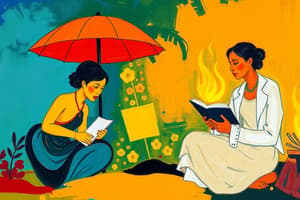Podcast
Questions and Answers
What does the analysis of grave goods commonly indicate about individuals?
What does the analysis of grave goods commonly indicate about individuals?
- Their dietary habits
- Their political affiliations
- Their social status (correct)
- Their religious beliefs
Books provide no insights into the social structures of different societies.
Books provide no insights into the social structures of different societies.
False (B)
What can burial customs reveal about a community?
What can burial customs reveal about a community?
Spiritual beliefs and rituals regarding life and death.
The ________ of historical texts allows us to trace the evolution of language and writing systems.
The ________ of historical texts allows us to trace the evolution of language and writing systems.
Match the following aspects of burial with what they reveal:
Match the following aspects of burial with what they reveal:
Flashcards are hidden until you start studying
Study Notes
What Books Tell Us
- Cultural Insights: Books provide a glimpse into the values, beliefs, and social structures of different societies.
- Historical Events: Documented accounts of events offer perspectives on political, social, and economic conditions of the time.
- Language Development: The evolution of language and writing systems can be traced through historical texts.
- Literature and Philosophy: Reflects the intellectual movements, ideologies, and artistic expressions of various eras.
- Religious Texts: Sacred writings reveal spiritual beliefs and practices, shaping moral and ethical frameworks in societies.
What Burial Tells Us
- Cultural Practices: Burial customs reflect the spiritual beliefs and rituals of a community regarding life and death.
- Social Status: Grave goods and the style of burial can indicate the social hierarchy and wealth of individuals.
- Funerary Art: Symbols and decorations provide insight into the artistic expressions and values of the culture.
- Health and Lifestyle: Analysis of remains can inform us about the diet, diseases, and living conditions of past populations.
- Trade and Interaction: Materials found in burial sites can indicate trade routes and cultural exchanges between different groups.
What Books Tell Us
- Books reveal the cultural values, beliefs, and social structures that shape various societies, acting as a mirror to their worldviews.
- Historical texts document significant events, offering insights into the political, social, and economic environments of different eras.
- The evolution of language and writing systems is evident in historical documents, showcasing the development of communication throughout time.
- Literature and philosophy encapsulate the intellectual movements and artistic expressions of distinct time periods, reflecting the thoughts and ideologies of those who created them.
- Religious texts provide a window into spiritual beliefs and practices, significantly influencing the moral and ethical considerations within cultures.
What Burial Tells Us
- Burial customs serve as a representation of a community's spiritual beliefs and rituals surrounding life and death, emphasizing their cultural identity.
- The presence of grave goods and burial styles can reflect individuals' social statuses and indicate wealth within a society, showcasing its hierarchy.
- Funerary art, including symbols and decorations, offers insights into the artistic values and aesthetic preferences of the culture at the time.
- Analysis of human remains from burial sites can yield important information regarding past diets, prevalent diseases, and living conditions of historical populations.
- Materials unearthed in burial contexts can reveal trade routes and cultural interactions, highlighting exchanges between different groups and regions.
Studying That Suits You
Use AI to generate personalized quizzes and flashcards to suit your learning preferences.




